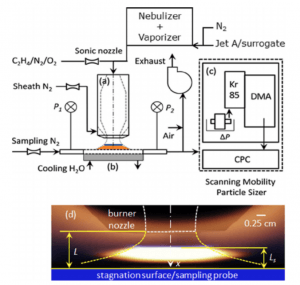A collaboration between Stanford University, the University of Connecticut, the University of Toronto, and George Washington University published in the journal Fuel.
Chiara Saggese, Ajay V. Singh, Xin Xue, Carson Chu, Mohammad Reza Kholghy, Tongfeng Zhang, Joaquin Camacho, Jennifer Giaccai, J. Houston Miller, Murray J. Thomson, Chih-Jen Sung, Hai Wang,
Abstract Real jet fuels are complex mixtures of many organic components, some of which are aromatic compounds.Towards the high-temperature end of the distillation curve, some of the fuel components are multi-ring com-pounds. A small amount of these high molecular weight species in the fuel could impact soot nucleation in practical engines especially when the fuel is injected as a spray. This work aims to highlight the variation of the sooting propensity of jet fuels as a function of distillate fractions and to examine the validity of a surrogate fuel in emulating soot production from real fuels. Particle size distribution functions and soot volume fractions are studied in a series of laminar premixed stretch-stabilized ethylene flames doped with Jet A, its various distillate fractions, and the 2nd generation MURI surrogate. Soot formation as a result of doping real jet fuel and its distillate fractions is also investigated in counterflow and coflow diffusion flames. The results show that the higher-boiling distillates mostly influence soot nucleation and produce substantially more soot in nucleation controlled flames than the light molecular fraction and jet fuel as received, while such an effect is seen to be small in flames where soot production is controlled by surface growth. The potential impact of distillate fractions on soot nucleation propensities is discussed
a Mechanical Engineering Department, Stanford University, Stanford, CA 94305, USA
b Department of Mechanical Engineering, University of Connecticut, Storrs, CT 06269, USA
c. Department of Mechanical and Industrial Engineering, University of Toronto, Toronto, Canada
d. Department of Chemistry, The George Washington University, Washington, DC 20052, USA

